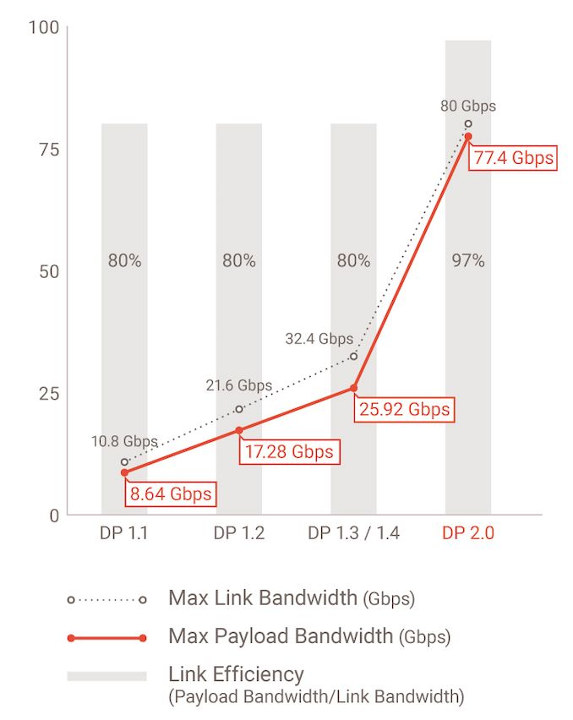4K monitors and TVs are now very common, and 8K displays, media players and camera are just coming to market and there’s still pretty expensive and content is basically nonexistent. 8K displays must be quite large or viewers must sit really close to get any benefit over 4K, but some people think 16K displays will be a thing in the not-to-distant future.
Announced in 2016, DisplayPort 1.4 took care of 8K 60Hz output thanks to a 32.4 Gbps link bandwidth and compression, but the Video Electronics Standards Association (VESA) has now announced DisplayPort 2.0 standard with support for one 16K display at up to 60 Hz, or two 4K displays at up to 144 Hz with HDR thanks to a 80 Gbps link bandwidth / 77.4 Gbps payload bandwidth.
DisplayPort 2.0 will work with either native DP connectors or USB Type-C connectors with DisplayPort Alt Mode for video and audio. DisplayPort 2.0 relies on Thunderbolt 3 physical interface (PHY) layer to achieve the higher bandwidth.
Beside the faster data rates, another interesting features of DisplayPort 2.0 is support for a display stream data mapping protocol common to both single-stream transport and multi-stream transport which will allow a single DP port on the source device to drive multiple displays either via a docking station or daisy-chainable displays.
Here are some of the new display configurations made possible by the new standard:
- Single display
- 16K (15360×8460) display @ 60Hz and 30 bpp 4:4:4 HDR (with DSC = Display Stream Compression)
- 10K (10240×4320) display @ 60Hz and 24 bpp 4:4:4 (no compression)
- Dual display
- 2x 8K (7680×4320) displays @ 120Hz and 30 bpp 4:4:4 HDR (with DSC)
- 2x 4K (3840×2160) displays @ 144Hz and 24 bpp 4:4:4 (no compression)
- Triple display
- 3x 10K (10240×4320) displays @ 60Hz and 30 bpp 4:4:4 HDR (with DSC)
- 3x 4K (3840×2160) displays @ 90Hz and 30 bpp 4:4:4 HDR (no compression)
- Multi-displays plus SuperSpeed USB data with two lanes on the USB-C connector used for DP Alt mode:
- 3x 4K (3840×2160) displays @ 144Hz and 30 bpp 4:4:4 HDR (with DSC)
- 2x 4Kx4K (4096×4096) displays (for AR/VR headsets) @ 120Hz and 30 bpp 4:4:4 HDR (with DSC)
- 3x QHD (2560×1440) @ 120Hz and 24 bpp 4:4:4 (no compression)
- 1x 8K (7680×4320) display @ 30Hz and 30 bpp 4:4:4 HDR (no compression)
The first products equipped with DisplayPort 2.0 (DP 2.0) are expected to launch at the end of 2020.
Via Liliputing and Anandtech

Jean-Luc started CNX Software in 2010 as a part-time endeavor, before quitting his job as a software engineering manager, and starting to write daily news, and reviews full time later in 2011.
Support CNX Software! Donate via cryptocurrencies, become a Patron on Patreon, or purchase goods on Amazon or Aliexpress






https://www.newsshooter.com/2018/12/01/8k-is-now-being-broadcast-in-japan/ NHK’s 8K (well it’s actually 7680 x 4320) broadcasts are now available on a daily basis on a special channel between the hours of 10 am and 10 pm. The picture quality of the broadcasts will be 16 x greater than that of HD, and audio will be delivered in 22.2 multi-channel. NHK will be broadcasting in frame rates of 59.94, 60 and 120P. ‘The first products equipped with DisplayPort 2.0 (DP 2.0) are expected to launch at the end of 2020.’ interestingly to late for the 2020 Summer Olympics as it will begin on Friday, 24 July https://www.dpreview.com/news/0406343392/japan-s-nhk-to-demo-8k-240fps-camera-and-broadcast-system-at-nab-2018… Read more »
Hybrid-Log Gamma (it created it jointly with the BBC). NHK’s engineers https://gizmodo.com/okay-this-argument-for-8k-tvs-is-kinda-convincing-1831745230 Okay, This Argument for 8K TVs Is Kinda Convincing Alex Cranz,1/15/19 10:12am …And this is where things get complex. Here we turn to a 2013 paper describing a study by a group of NHK engineers. The NHK is Japan’s public broadcasting organization—think PBS or the UK’s BBC—and it is heavily involved in creating broadcast standards, encoder types, and even the very first HDR standard for broadcasting, Hybrid-Log Gamma (it created it jointly with the BBC). NHK’s engineers posited that there is a distance where an object on a… Read more »
Shame that everything NHK broadcasts is either mind numbingly boring or kids tv really.
> To that end, NHK also plans to showcase a new 8K VR display during NAB 2018. The display is designed to eliminate the pixelated look common to current VR headsets….
2x 8K (7680×4320) displays @ 120Hz will still be rather pixelated.
i cant speak as to what the “new 8K VR display during NAB 2018″ spec was, i do know that BBC engineering with NHK, did engineer and test 50,59.94,100,150,200,250,300 Hz as the REQUIRED real standard they layed out,along side the upto 22.2 engineering required . 6 years ago their display partners did a prototype (i forget the exact size,recall) 3.5″/7″ 4k and 8k as a POC ,so if you take nhk papers above as a given, then human eye vr focal point times 1.5 the hight of a generic 3.5″/7” display at upto 300 Hz for VR gives you a… Read more »
Yep – I think 8K TVs used for Tokyo 2020 will require multiple HDMI inputs for 8K/120 (the 8K/60 sets I saw on sale in Japan were using Quad 4K = 4 x HDMI 2.0 inputs) HDMI 2.1 delivers 8K/60 inputs on a single connector, but doesn’t support 8K/120 – which is the standard that some Tokyo 2020 stuff will be produced in I believe. 8K120 will require either 2 x HDMI 2.1 8K/60 inputs interleaved, or 4 x HDMI 2.1 4K/120 inputs running in Quad 4K (where you have the option of running in either 4 x 1/4 screen… Read more »
I’m interested in how the Thunderbolt 3 PHY bit integrates with all this. Only devices with TB3 support will work with displayport 2.0? What does that mean for AMD and ARM systems that have yet to pick up TB3 despite the standard being made royalty free (iirc)?